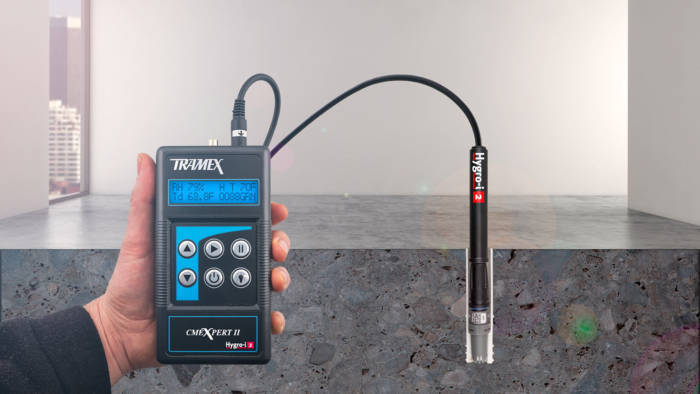
How simple, instant and non-destructive tests will save you time and money on your RH testing and strengthen your reputation.
Whether your chosen or specified moisture testing method is the Relative Humidity test (F2170) or the Calcium Chloride moisture vapor emission rate test (F1869), it simply makes sense to start out with instant and non-destructive impedance testing per ASTM F2659. What better way is there to rapidly moisture map the slab so as to save time and money when performing your chosen test method? By simply pressing the non-destructive moisture meter onto the slab at any time during the drying period, you get an instant Moisture Content (MC%) reading and can assess the overall moisture conditions.
This allows you to decide if the floor slab is ready for the RH test, or if it may be too soon. Mapping also allows you to identify the wettest areas of the slab and where best to situate the RH probes. As a rule of thumb, high MC% readings found during moisture mapping are an indication of probable high RH% results. A decision can be made on this basis to allow for more drying time before performing RH% test as per F2170. Remember, F2170 requires that both floor slab and air space above the floor slab be at service temperature for at least 48 hours prior to taking measurements and that 24 hours is the required time for the air space within the hole to achieve equilibrium before making RH measurements.
As such, instant and non-destructive preliminary testing per F2659 helps save time and money by optimising your decision making as to when and where to perform F2170 RH tests. But impedance testing is not only worthwhile prior to your RH tests. It is also a most useful test to perform post-RH test, at the time of the installation of the floor coating or covering. Even if appropriate and specified RH% result levels have been achieved, and the floor slab is considered dry enough to receive the floor coating or covering, moisture related problems can still occur on the surface at the time of installation.
RH tests are performed at 40% of the depth of the slab and predict the moisture conditions at the surface at the time of installation. They would not, however, detect dew point moisture that occurs at the time of installation upon the surface. Non-destructive impedance testing allows for just that, thus providing an instant and vital green or red light before proceeding with the final installation of the floor coating or covering. Always remember to test the ambient relative humidity too, as installation should take place in conditions of between 40% to 60% RH, as per most manufacturer’s specifications.